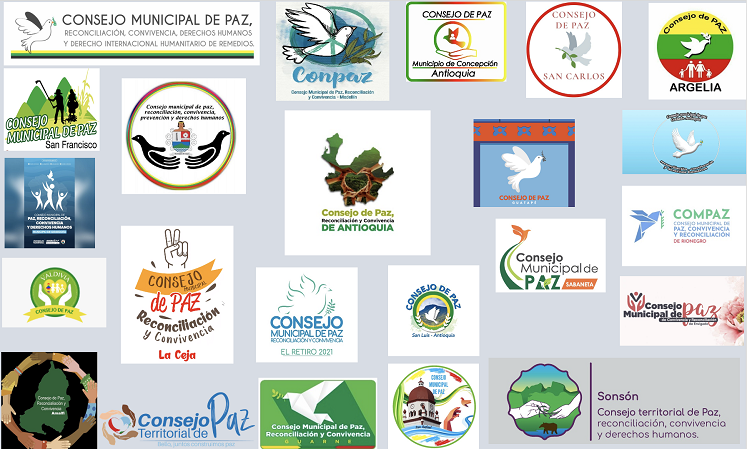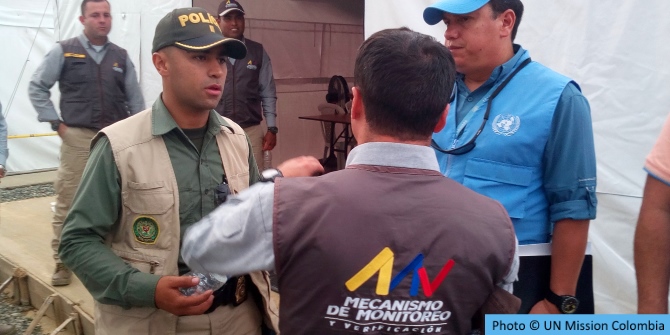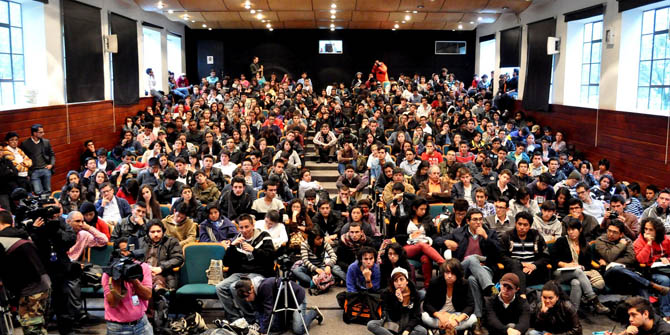Peacebuilding in Colombia needs to be anchored in the resolution of armed conflicts and dialogue among actors in local territories. The Territorial Peace Councils have the potential to contribute to such dialogue and rebuild trust in the state, a key task for peace, as analysed by Angélica Sepúlveda (formerly local liaison officer of the Office of the High Commissioner for Peace of the Colombian government) and Gwen Burnyeat (Merton College, University of Oxford).
Lee este post en español
The Territorial Councils for Peace, Reconciliation and Coexistence are under-visiblised in the international scrutiny of the 2016 peace accord signed between the Colombian government and the Revolutionary Armed Forces of Colombia-People’s Army (FARC-EP) guerrilla group. In the context of the new government of Gustavo Petro and his ‘total peace’ (paz total) policy, which promises implementation of the 2016 accord and negotiate with the remaining armed groups, these councils could play a fundamental role. But, so far, President Petro has not invoked them directly.
The Territorial Councils for Peace, Reconciliation and Coexistence (TCPRC) were created within the point of the peace accord on political participation. This point served to reconstitute the National Peace Council, created in 1998 to advise the national government on peace and was inactive for 19 years. Additionally, this point defined the creation of the territorial councils in an analogous manner to the national council, with the function of advising mayors and governors in each municipality and department.
Opportunities
The National Peace Council and the TCPRC are key scenarios for citizen participation in peacebuilding, and they comprise representatives of civil society and state institutions. The National Council is presided by the President of the Republic and has 35 representatives from state institutions, including from the cabinet, the executive and legislative branches of the government, the armed forces, and the control organs. It also has 70 representatives from civil society from diverse social sectors, including the church, human rights defenders, former combatants from the FARC-EP, academia, the business sector, conflict victims, and the LGTBIQ+ community, among others.
The TCPRC are composed similarly at departmental and municipal levels, and they are important to achieve what the 2016 peace accord called territorial peace. This principle recognises the varied dynamics of the conflict across different regions and proposes to address local problems in a differential manner, anchored in the participation of local actors. This approach is of heightened relevance for the new government, as one of his key proposals is to carry out “binding regional dialogues” to achieve peace. The TCPRC represent an already-existing social capital in terms of dialogue spaces for peacebuilding, and it is crucial to take advantage of this.
Historically, there is widespread distrust in the state in Colombia due to the actions of state agents in the internal armed conflict and to the deep-rooted perception that the state has “abandoned” many regions of the country. Repairing the state-society relationship is one of the key challenges in peacebuilding. In this scenario and under the new government, there is an opportunity to build a new government-society alliance for peace. Due to their mixed composition (state and civil society), the TCPRC are a scenario where trust-building can advance.
Since 2017, under the government of Juan Manuel Santos, the Office of the High Commissioner for Peace (OACP) had the task of stimulating the creation by each local government (mayoralties and governorships) of its respective territorial councils via 26 local liaison officers stationed around the country. This work was maintained as a priority for the OACP during the government of Iván Duque, despite his ambiguous position on the implementation of the peace accord. To date, 48.3% of municipalities (533 municipalities) and all 32 departments have their TCPRC created on paper. This represents over 13,000 people in total who have been invested as peace councillors, have begun to work as a team, and have received capacity-building by peacebuilding organisations, academics, and representatives of agencies in charge of implementing the peace accord, such as the Truth Commission and the OACP.
However, one thing is having the normative framework established, and another is the real functioning of these bodies. This depends on various elements: the political will of the local authority (mayor or governor) to participate in the TCPRC and give it human and financial resources, the empowerment of councillors in their role as advisors to local government, and the role given to the TCPRC in the national policy of ‘total peace’.
Achievements of the Councils in Eastern Antioquia
The potential of these councils has been shown in Eastern Antioquia (Oriente Antioqueño), a region of 23 municipalities in the department of Antioquia. Some of the TCPRCs have participated in the resolution of local social conflicts. For example, in the municipality of Marinilla, during the nationals trike of 2021, which received international attention partly due to the violence it generated, the TCPRC held meetings with the police and requested accompaniment and protection for the demonstrators, and designed a protocol for guaranteeing the security of those engaged in social protest. Thanks to their work of mediation and observation, in Marinilla, there were no incidents of violence either by police toward protestors no acts of aggression by protestors toward police.
In the municipality of Guatapé, the TCPRC identified that begging and child prostitution were sources of local conflict. The council decided to run a pedagogical campaign and collect donations via the church, which is part of the TCPRC in that municipality and has various programs to support families who are engaging in begging.
Several municipalities have established spaces of dialogue between different local actors to treat local conflicts. For example, the municipalities of San Carlos and San Luis have led dialogues with teachers and students, radio programs, and community dialogue events to reflect on peaceful coexistence. The municipality of San Luis has also led dialogue spaces, specifically between the community and hydroelectric energy companies, in order to carry out citizen oversight.
The municipality of San Carlos, which was deeply affected by violent actions by the FARC, won a project with funds from the United Nations Development Programme (UNDP) to implement dialogues on truth and to promote the dissemination of the final report of the Truth Commission and its transmedia material. Such spaces are fundamental to recognising the wounds of the past and constructing processes of reconciliation and healing. The peace councillors are ideally situated to lead these processes, as they know the local realities and have everyday relationships with local inhabitants.
The TCPRC can also influence national peace policies. During August, September and October of 2022, the TCPRC of Marinillia led a series of summits in the 23 municipalities of Eastern Antioquia, followed by 4 zonal summits which grouped municipalities together, and then a summit for the whole region, inviting actors who generally do not talk to each other to participate in a dialogue about the needs of the region, for example, representatives of local chambers of commerce and human rights defenders. This work generated a document that served as input to the National Development Plan, presented in the binding regional dialogue of the region, with themes such as the conservation of local natural resources, legalisation of land titles, the promotion of local policies on peace and reconciliation, and the strengthening of community leadership, among others. This kind of work of bridge-building between different sectors is fundamental for peacebuilding.

Challenges for the Councils
There are several challenges to overcome for the TCPRC to achieve their potential. One is the lack of interest and political will of several local government authorities. There is wide variability across the TCPRC between those municipalities or departments with interested and committed mayors and governors and others where the mayors or governors are reluctant to get involved in issues to do with peace due to their political orientation or if they do not perceive the utility of the TCPRC.
The OACP local liaison officers who promoted in each municipality and department the creation of the TCPRC have continued accompanying them, and often they have had to pressure local mayors and governors to participate. However, when the liaison officers have diminished their accompaniment, the advances have ground to a halt. One concern is the fact that with the change of government, most of the liaison officers have been removed, and there is no entity in the central government monitoring the mayors and governors to check their fulfilment of the obligations of local governments in the councils.
Another challenge is the inequality between the participation of civil society councillors and councillors from state institutions. State employees who participate in the councils do so as part of their paid job. Councillors from civil society, however, participate without financial recompense. There are no stipends of any kind for them, they do not even get their transport or accommodation paid for them to travel to meetings, and some councillors have to travel from rural areas to attend. The OACP has, in some cases, financed some logistical aspects (food, transport, accommodation), but it has been insufficient.
Recognising the potential of the Councils
In this new context in which the Petro government seeks to resolve different conflicts in Colombia and build peace via regional dialogues and empowerment, the TCPRC represent powerful capital. The peace councillors could become local leaders of total peace. But for this to be possible, it would be important for Gustavo Petro and his High Commissioner for Peace, Danilo Rueda, to recognise the potential of these already-existing spaces, and include them in the national peace policy and the labour of the OACP in the regions.
If there was real monitoring of local mayors and governors as those most responsible for the councils, the TCPRC could act as mediators between central and local governments on peace issues. The new law of public order proposes to create regional peace commissioners: this could be an opportunity for such mediation and could take advantage of the potential of the TCPRC’s potential.
For the TCPRC to be more sustainable, it would be important to modify decree 885/2017, which regulates them, to include thus far excluded sectors, such as prisoners, sex workers, migrants and homeless people. Additionally, it is necessary to pay a day’s minimum wage to those who travel to council meetings and pay for their transport and accommodation, as well as giving councillors means of identification such as shirts or vests so that their leadership can be made visible, to give them legitimacy in their territory and also as a means of protection, as some of them are working in conflict regions.
With more financial resources, the councils could have guarantees for their everyday functioning and a definitive place to meet. With these modifications, the TCPRC could increase their potential and become spaces for building total peace.
Notes:
• The views expressed here are of the authors rather than the Centre or the LSE
• Please read our Comments Policy before commenting
• Banner image: Peace council meeting in Alejandría, Colombia / Angélica Sepúlveda





